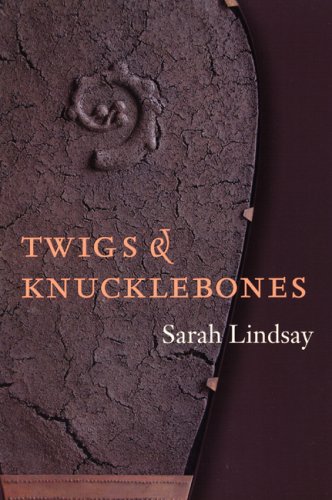 Sarah Lindsay is in the minority, a poet uninterested in the self.
Rare is the appearance of the first-person pronoun in her 2008 collection, Twigs & Knucklebones, a conspicuous absence that sets her apart from other poets compelled to reveal and confess every secret shame.
Sarah Lindsay is in the minority, a poet uninterested in the self.
Rare is the appearance of the first-person pronoun in her 2008 collection, Twigs & Knucklebones, a conspicuous absence that sets her apart from other poets compelled to reveal and confess every secret shame.
Even the sole love poem, “Stubbornly,” is externalized, cordoned off from the self. No one gives or receives love. It’s a mock argument over poetic symbols of love. Lindsay picks the unlikely lichen over the “showy rose” and the “changeless diamond,” because the “alga and fungus [that] made one fleck” will continue:
crocheting its singular habit over time, a faithful stain bound to its home, etching on the unmoved rock the only rune it knows.
Lindsay does this kind of thing throughout Twigs & Knucklebones. To express what’s inside, like love, she turns to the material world. Of course, this is what poets do. Her poetics call to mind William Carlos Williams, who advised poets to let ideas emerge from things rather than things from ideas. In “Stubbornly,” love is not like lichen; it’s lichen, rather, that’s like love. A “faithful stain,” something that doesn’t go away, that combines with a “singular habit,” a behavior that’s focused and steady, best fits love as a metaphor. In this way, what appears ironic might instead be read as something heartfelt and genuine.
Lindsay resembles Williams in another way — she has a day job. The 1997 nominee for the National Book Award is a copy editor for a company that publishes trade magazines. Williams linked his poetics with his profession as a doctor, in which he experienced the immediate and “the local” every day: “That is the business of a poet,” he wrote. “Not to talk of vague categories but to write particularly, as a physician works, upon a patient, upon the thing before him, in the particular to discover the universal.”
I don't mean to make too fine a point of this, but I’m sure Lindsay spends time working on the thing in front of her, the words that need her attention, and dealing with its immediate particulars, words and their meaning. Given the mostly unambiguous nature of copy editing — language is used correctly or not — Lindsay likely avoids Williams’ “vague categories” in her daily routine. If she’s like other writers at all, the force of habit at least informs aesthetic principle and not as much the other way around. So my gut tells me this copy editor-poet finds value in intensifying the “external moment,” as Williams advised, stuffing her poems with all sorts of concrete things from the natural and ancient worlds.
 In “Why We Held On,” an external moment begins with the slow gathering of petty details and culminates in what Williams might have called a “radiant gist” — an image so clear that you get it without knowing you’ve gotten it.
In “Why We Held On,” an external moment begins with the slow gathering of petty details and culminates in what Williams might have called a “radiant gist” — an image so clear that you get it without knowing you’ve gotten it.
Future doctors, Lindsay writes, may learn that an infestation of parasites in our minds explains why we cling to the past, to the “illusionary satisfaction” of mimicking “the letter / that mentioned Granny’s mules were named Huldy and Tom.” We obsess over “the leavings of people we couldn’t get back, / wouldn’t see again or never saw —.” Even so, “[i]t wasn’t our fault.” We cling just as:
the housefly filled with a fungus knows only that it must land in a high place, and dies there obligingly in an odd position suitable for the firing of spores at sunset.
What an image!
Sure, it’s a grim worldview that sees human behavior as pre-determined as a housefly’s gut fungus. And sure, it’s made grimmer by Lindsay’s lucid style in compact lines. But cynicism in Twigs & Knucklebones is often counterbalanced by the sublimity of her images and the force of their implications.
That includes the disconnect between nature and man — the workings of an amoral universe independent of human notions of morality. Good and bad don’t really apply to nature. She’s perfectly indifferent. Even so, how do we “labor to comprehend” and find meaning in a world, Lindsay writes in “Song of a Spadefoot Toad”:
where minute crustaceans pierce the side of a swordfish to lodge in its heart, where spadefoot toads wake from eleven months’ sleep and sing till their throats bleed, where humans do everything that humans do, where a fig wasp pollinates a flower while laying her eggs, then lies on her side as baby nematodes crawl from her half-eaten gut … ?
Lindsay frequently returns to parasites. It seems they are an apt metaphor for her tragic worldview. Parasites need a host but slowly kill it in spite of themselves. One's desires lead to one's undoing. And Lindsay jams human behavior inside a list of horrible things parasites do, obscuring the divide between thing and idea: Are we like parasites — or are parasites like us?
But just as you find tragedy, you also find external moments of stunning beauty.
At the end of “Spadefoot Toad,” Lindsay answers despair with another image. Meaning can be found inside this image, the thing itself, but unlike a rose or a diamond, it has no metaphysics beyond itself. It is what it is — a thing of beauty, a stripped down picture in which we might take comfort.
These images reflect a wholeness of understanding in Twigs & Knucklebones, an old-fashioned way of seeing the world that used to be called wisdom, in a place:
where faithfully every day in a mangrove shallows paired seahorses — armless, legless, without expression — dance with each other at sunrise.
ABOUT THE BOOK Twigs & Knucklebones by Sarah Lindsay Copper Canyon Press, 117 pages, $15